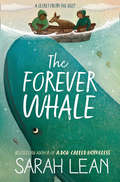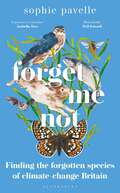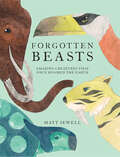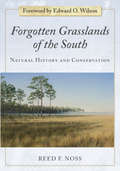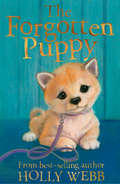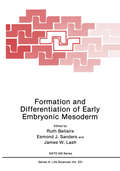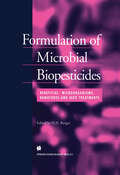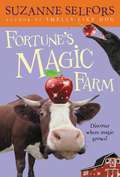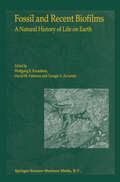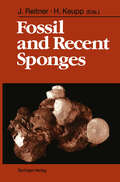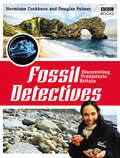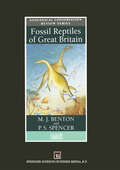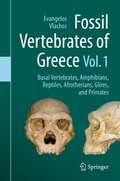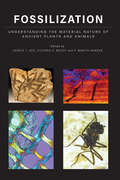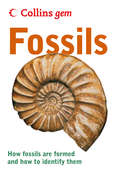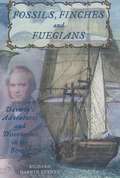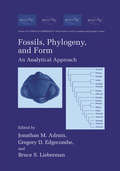- Table View
- List View
The Forever Whale: A Dog Called Homeless, A Horse For Angel, The Forever Whale
by Sarah LeanA family secret waiting to be discovered… from bestselling author of A Dog Called Homeless.
Forget Me Not: Finding the forgotten species of climate-change Britain
by Sophie PavelleJoin Sophie Pavelle on a low-carbon journey around Britain in search of ten animals and habitats threatened by climate change in the 21st centuryForget-me-not – a beautiful flower and a plea from our islands' wildlife. When climate change has driven dozens of our most charismatic species to extinction, will they be forgotten? Like many of her generation, Sophie Pavelle is determined to demand action on climate change. In her hilarious and thought-provoking first book, she describes the trips she took to see ten rare native species: species that could disappear by 2050 and be forgotten by the end of the century if their habitats continue to decline. Sophie challenged herself to find them the low-carbon way, travelling the length of Britain on foot, by bicycle, in an electric car, by kayak, on ferries and in a lot of trains. From Bodmin Moor to the Orkney Islands, Sophie encountered species on the frontline of climate change in Britain. Which are going to be seriously affected, and why? Could some bounce back from the brink? Or are we too late to save them? Forget Me Not is a clarion call: we all need to play a part in tackling this most existential of threats. Everyone can see wildlife in the British Isles without contributing to its destruction. With joyful irreverence, Sophie shows us we can dare to hope. Journey with her, and she may even inspire you to take action for nature and head out on your own low-carbon adventure.
Forging On: A warm laugh out loud funny story of Yorkshire country life
by Catherine Robinson'Wonderfully warm and funny' Cathy Woodman, bestselling author of Trust Me I'm A VetWill is a Yorkshire lad, through and through. He's in his element when he's outside in the country air, not stuck in a classroom wasting his youth and the beauty of Yorkshire. When he starts as an apprentice farrier, his first few days are a baptism of fire. His fellow apprentice is a wind-up merchant and his gruff boss, Stanley, ribs him mercilessly about his tea drinking habit. But in this chaotic environment, the three of them form a brotherhood, and soon, Will realises that the coming year is going to teach him a lot more than how to shoe a horse properly...A charming story full of dry Yorkshire humour and warmth - a must-read for fans of James Herriot, Clare Balding, Countryfile and The Shepherd's Life.
Forgotten Beasts: Amazing Creatures That Once Roamed The Earth
by Matt SewellWhat do you know about the our planet's strangest extinct creatures? Less celebrated than the dinosaurs, these beasts are equally impressive. Enjoy Matt Sewell's characteristic watercolour illustrations and witty, fascinating descriptions of these amazing creatures that once did stalk the planet.
Forgotten Grasslands of the South: Natural History and Conservation
by Reed F NossForgotten Grasslands of the South is the study of one of the biologically richest and most endangered ecosystems in North America. In a seamless blend of science and personal observation, renowned ecologist Reed Noss explains the natural history of southern grasslands, their origin and history, and the physical determinants of grassland distribution, including ecology, soils, landform, and hydrology.In addition to offering fascinating new information about these little-studied ecosystems, Noss demonstrates how natural history is central to the practice of conservation. Although theory and experimentation have recently dominated the field of ecology, ecologists are coming to realize how these distinct approaches are not divergent but complementary, and that pursuing them together can bring greater knowledge and understanding of how the natural world works and how we can best conserve it.This long-awaited work sets a new standard for scientific literature and is essential reading for those who study and work to conserve the grasslands of the South as well as for everyone who is fascinated by the natural world.
The Forgotten Puppy (Holly Webb Animal Stories #29)
by Holly WebbEmi looks forward to her weekend visits to her dad’s, but she’s sad that her Shiba Inu puppy, Rina, can’t come too. During the school holidays, Emi visits her dad for four whole days, and Rina is restless – what if Emi doesn’t come back? Determined to find her owner, Rina escapes and heads to the last place she saw Emi – the railway station… A heart-warming read, perfect for fans of Magic Animal Friends and Animal Ark.
Form and Function of Mammalian Lung: Analysis by Scientific Computing (Advances in Anatomy, Embryology and Cell Biology #145)
by Andres Kriete1.1 Overview The precise knowledge of the three-dimensional (3-D) assembly of biological structures is still in its origin. As an example, a widely accepted concept and common belief of the structure of the airway network oflung is that of a regular, dichotomous branching pattern, also known as the trumpet model. This model, first introduced by Weibel in 1963, is often used in clinical and physiological applications. However, if this concept of dichotomy is used to model lung, a shape is obtained that is quite different from a real lung. As a matter of fact, many previous quantitative morphological and stereological investigations of lung did not concentrate on the spatial aspect of lung morphology but delivered data in a more statistical fashion. Accordingly, the functional behavior predicted by such a model becomes questionable and indeed, the morphometrically predicted lung capacity exceeds the physiological required capacity by a factor of 1.3 up to a factor of2. This problem has also been termed a paradox, as discussed by Weibel in 1983. In the rare cases where descriptive models of the mammalian bronchial tree exist, monopodial in small mammals, dichotomous in larger ones, the understanding of the historical and/or functional reasons for size-related changes in the general design is not explainable. This investigation is trying to overcome this gap by computer modeling and functional simulation.
Form Versus Function: Theory and Models for Neuronal Substrates (Springer Theses)
by Mihai Alexandru PetroviciThis thesis addresses one of the most fundamental challenges for modern science: how can the brain as a network of neurons process information, how can it create and store internal models of our world, and how can it infer conclusions from ambiguous data? The author addresses these questions with the rigorous language of mathematics and theoretical physics, an approach that requires a high degree of abstraction to transfer results of wet lab biology to formal models. The thesis starts with an in-depth description of the state-of-the-art in theoretical neuroscience, which it subsequently uses as a basis to develop several new and original ideas. Throughout the text, the author connects the form and function of neuronal networks. This is done in order to achieve functional performance of biological brains by transferring their form to synthetic electronics substrates, an approach referred to as neuromorphic computing. The obvious aspect that this transfer can never be perfect but necessarily leads to performance differences is substantiated and explored in detail. The author also introduces a novel interpretation of the firing activity of neurons. He proposes a probabilistic interpretation of this activity and shows by means of formal derivations that stochastic neurons can sample from internally stored probability distributions. This is corroborated by the author’s recent findings, which confirm that biological features like the high conductance state of networks enable this mechanism. The author goes on to show that neural sampling can be implemented on synthetic neuromorphic circuits, paving the way for future applications in machine learning and cognitive computing, for example as energy-efficient implementations of deep learning networks. The thesis offers an essential resource for newcomers to the field and an inspiration for scientists working in theoretical neuroscience and the future of computing.
Formation and Differentiation of Early Embryonic Mesoderm (Nato Science Series A: #231)
by Ruth Bellairs Esmond J. Sanders James W. LashMesodenn is a key tissue in early development. It is involved in the differentiation of almost every organ in the body, not merely as a structural component, but as an active participant in the establishment of diverse cell types. All mesodenn is derived from ectoderm. Its appearance signals the start of a significant new phase in the development of the embryo. At this time all three genn layers are now present and myriad sequences of cell and tissue interactions begin to occur which will eventually give rise to the entire embryo. The control of the growth and differentiation of the mesoderm is critical for the production of a normal individual. Indeed, disturbance of the patterning of the mesoderm or of its interaction with other tissues plays a critical part in the fonnation of most congenital anomalies. The main focus of this book is therefore on the establishment, divergence and specialisation of mesodermal derivatives. The central role of the mesoderm in development has long been appreciated and a wide literature exists on its activity in certain specialised situations. Recently, however, an impetus to its study has been provided by new approaches opened up through biotechnological advances. Many of these advances are reflected in the reports in this volume. Scientists from various disciplines have become drawn to mesodermal tissues, and this volume may help them find a framework within which their work will fit.
Formation of the Heart and its Regulation (Cardiovascular Molecular Morphogenesis)
by Robert J. Tomanek Raymond B. RunyanThe `Formation of the Heart and its Regulation` reviews in considerable detail the major events in heart development and their control via genes, cell-cell interactions, growth factors and other contributing elements. In addition, there is an extensive and useful overview of the field of heart development taken as a whole. The book will appeal to all students and researchers working on cardiovascular development and to pediatric cardiologists.
The Formation of Vegetable Mould Through The Action of Worms - With Observations on Their Habits
by Charles DarwinFormulation of Microbial Biopesticides: Beneficial microorganisms, nematodes and seed treatments
by H.D. BurgesSound formulation is a vital aspect of microbial products used to protect plants from pests and diseases and to improve plant performance. Formulation of Microbial Biopesticides is an in-depth treatment of this vitally important subject. Written by experts and carefully edited, this important title brings together a huge wealth of information for the first time within the covers of one book. The book is broadly divided into five sections, covering principles of formulation, organisms with peroral and contact modes of action, organisms with the power of search, and future trends. Each section contains comprehensive chapters written by internationally acknowledged experts in the areas covered; the book also includes three very useful appendices, cataloguing formulation additives, spray application criteria and terminology. This outstanding book is a vitally important reference work for anyone involved in the formulation of microbial biopesticides and should find a place on the shelves of agriculture and plant scientists, microbiologists and entomologists working in academic and commercial agrochemical situations, and in the libraries of all research establishments and companies where this exciting subject is researched, studied or taught.
Forschung ohne Tierversuche 1996 (Ersatz- und Ergänzungsmethoden zu Tierversuchen)
by Harald Schöffl Klaus Cußler Horst Spielmann Helmut A. Tritthart Antoine F. Goetschel Franz P. Gruber Christoph A. ReinhardtDer vierte Band der Reihe bietet eine interdisziplinäre Darstellung des aktuellen Standes der Wissenschaft auf dem Gebiet der Ersatz- und Ergänzungsmethoden zu Tierversuchen. Die Schwerpunkte dieses Buches sind die Gebiete Neuro- und Reproduktionstoxikologie ebenso wie die Onkologie, Biometrie, Immunisierung und Adjuvantien. Aufgrund der bevorstehenden, gravierenden Rechtsänderungen auf europäischer Ebene verdient das Kapitel toxikologische Prüfungen von Kosmetika in der EU besondere Beachtung. Ein abschließendes Kapitel ist auch wieder dem Bereich Recht und Ethik gewidmet. Gerichtsverfahren in Deutschland, Diskussionen über nationales und EU Recht und die stärker werdende Sensibilisierung für ethische Belange haben neue Fragen aufgeworfen.
Fortune and the Golden Trophy (Pony Club Secrets #7)
by Stacy GreggThe seventh gripping adventure in this exciting pony-club series. With gymkhanas to win, rivals to defeat, mysteries to solve and ponies in danger to save – these books are perfect for all girls who love ponies.
Fortune's Magic Farm
by Suzanne SelforsEverything changes when Isabelle discovers that she is the heir to Fortune's Farm, a wondrous place where the final remnants of magic grow. For as long as she can remember, ten-year-old Isabelle has dreamed of escaping her home in Runny Cove, a gray village where it never stops raining, and where she is forced to work at Mr. Supreme's Umbrella Factory.Journeying across the ocean, Isabelle finds a sunny new home filled with magical delights, including Curative Cherry trees that can heal all kinds of sickness, and Floating Fronds that make her fly. But Isabelle still feels the call to return to Runny Cove and use the secrets of the farm to stop the rain. With the magic of Fortune's Farm behind her, will Isabell be strong enough to bring back the sun and stop the despicable Mr. Supreme? From the author of Smells Like Dog comes a magical journey about loyalty, family, and the magic within.
Fossil and Recent Biofilms: A Natural History of Life on Earth
by W. E. Krumbein D. M. Paterson G. A. ZavarzinMICROBIAL BIOFILMS: PROTECTIVE NICHES IN ANCIENT AND MODERN GEOMICROBIOLOGY J. W. Costerton and Paul Stoodley Center for Biofilm Engineering Montana State University As this book is published based on discussions of a conference that was held in 2001, it may be useful to provide an update on the most recent revelations about biofilms, so that this excellent exposition of the contribution of microbial biofilms to geological processes may be placed in a modem context. The importance of the contribution of microbial biofilms to global processes is only now being appreciated as it is revealed that all terrestrial surfaces are teeming with microbial life in the form of biofilm communities. These communities live on soil particles, in rock fissures, marine and river sediments and at the very extremes of terrestrial habitats from inside Antarctic ice to the walls of deep sea hydrothermal vents. The contribution of these biofilm communities generally went unrecognized because it was the water that was where microbiologists looked for life, not the surfaces, although, evidence of the early association of microbes with surfaces was in fact present in the fossil record (Rasmussen, 2000; Reysenbach, and Cady, 2001). It is also revealing that biofilm formation is found in prokaryotes from the most deeply rooted branches of the phylogenetic tree in both the Archaea and Bacteria kingdoms, the Korarchaeota and Aquificales respectively (Jahnke et al. 2001; Reysenbach et al. 2000).
The Fossil Detectives: Discovering Prehistoric Britain
by Douglas Palmer Hermione CockburnFossils provide us with a tantalizing glimpse of Britain's prehistoric past and hold the key to unlocking the secrets of life's history and evolution. Since the appearance of primitive organisms in Britain more than a billion years ago, oceans, deserts, swamps and vast mountains have come and gone in our corner of western Europe; forests of long-extinct trees, flowers and grasses have covered the land, and dinosaurs and other strange creatures have roamed across it. How do we know? The evidence is all around us - in the rocks and fossils that lie beneath the landscape.In this highly informative and practical book, which accompanies the BBC series, presenter Hermione Cockburn and renowned palaeontologist Douglas Palmer take an in-depth look at the most exciting fossil stories from around the country. When and why were dinosaur fossils first discovered in Britain? How was the biggest fish ever to have swum in the sea unearthed near Peterborough? What do modern medical techniques have to offer fossil hunters?Packed with colour photographs and illustrations, Fossils Detectives is full of surprising facts and features. And for those who want to try their hand at some fossil detecting of their own, the book includes an extensive regional gazetteer of fossil-hunting sites and places to visit, and guidance on identifying your fossil finds.Get ready for some time travel around Britain, with the Fossil Detectives!
Fossil Reptiles of Great Britain
by M.J. Benton P.S. SpencerThis volume details all British sites that have yielded fossil reptiles, describing in detail the fifty most important localities and providing an extensive bibliography of everything published on British Fossil reptiles since 1676.
Fossil Vertebrates of Greece Vol. 1: Basal vertebrates, Amphibians, Reptiles, Afrotherians, Glires, and Primates
by Evangelos VlachosThis 2-volume set provides a state-of-the-art study of the fossil record and taxonomy of the main vertebrate groups from Greece. Greece stands between 3 continents and its vertebrate fossil record is of great importance for paleontological and evolutionary studies in Europe, Asia and Africa. Fossils from classic, world-famous localities (e.g., Pikermi, Samos) form an essential part of the collections of the most important museums in the world and have been studied by numerous scientists. Recent paleontological research led to the discovery and study of numerous new sites. The volumes contain a taxonomic review of all named and identified taxa, their taxonomic history and current status, as well as historical, phylogenetic and biogeographic information. Volume 1 contains a synopsis of the fossil record and taxonomy of important groups of vertebrates represented in the fossil record of Greece. The volume deals with some of the early splitting clades, including the basal and enigmatic conodonts and basal tetrapods like fishes, amphibians, and reptiles like lizards, snakes, crocodiles, turtles and tortoises. The second part of the volume deals with basal mammalian clades, some of which are quite characteristic for the fossil record of the country: aardwarks, hyraxes, proboscideans, elephants and mammoths, sea cows, rodents, and lagomorphs. The volume ends with special chapters on the primate fossil record of the country, including some of our most recent and distant relatives.
Fossilization: Understanding the Material Nature of Ancient Plants and Animals
by Carole T. Gee, Victoria E. McCoy, and P. Martin SanderUnderstanding the complex interplay of physical and chemical processes leading to fossilization is crucial to elucidating the 3800 million years of life on earth. And yet, the process of fossilization also leads to the loss of pivotal biological information, placing constraints on the very same understanding of ancient life it preserves. Over the last decade, however, remarkable advances in approaches, techniques, tools, and instrumentation have helped scientists to transcend these constraints by enabling high-resolution analysis of fossil material—even down to the nanoscale. Fossilization provides a critical look at these cutting-edge innovations in the science of fossil preservation and provides a road map for future research. Drawing from the fields of paleontology, organic and inorganic chemistry, microbiology, and high-resolution imaging and analysis, and spanning the diversity of life from plants to vertebrates and invertebrates, this resource details expert findings on• fossilization of hard and soft part tissues in dinosaurs• high-resolution chemical analysis of organic and inorganic tissues• arthropods preserved in amber• experimental silicification of wood• chemical defenses and color in fossil plants • confocal Raman spectroscopy• microprobe analysis• radioisotopic studies• and much moreA true interdisciplinary undertaking, the book is authored by paleontologists, mineralogists, geochemists, organic chemists, microbiologists, and materials scientists who have worked together to investigate questions around substance fossilization and the limits of the fossil record. A special color section contains SEM, Raman, and other striking images of vertebrates, invertebrates, and plants. Fossilization is a trailblazing reference book for research scientists and specialists in related fields, as well as for advanced undergraduates and graduate students interested in fossilization, emerging research techniques, and fresh approaches in the analysis of plant and animal fossils.Contributors: H. Jonas Barthel, Aurore Canoville, Carole T. Gee, Thorsten Geisler, Jens Götze, Conrad C. Labandeira, Sashima Läbe, Moritz Liesegang, Victoria E. McCoy, Martina Menneken, Jes Rust, P. Martin Sander, Frank Tomaschek, Torsten Wappler, Kayleigh Wiersma, Tzu-Ruei Yang
Fossilization: Understanding the Material Nature of Ancient Plants and Animals
by Carole T. Gee Victoria E. McCoy P. Martin SanderUnderstanding the complex interplay of physical and chemical processes leading to fossilization is crucial to elucidating the 3800 million years of life on earth. And yet, the process of fossilization also leads to the loss of pivotal biological information, placing constraints on the very same understanding of ancient life it preserves. Over the last decade, however, remarkable advances in approaches, techniques, tools, and instrumentation have helped scientists to transcend these constraints by enabling high-resolution analysis of fossil material—even down to the nanoscale. Fossilization provides a critical look at these cutting-edge innovations in the science of fossil preservation and provides a road map for future research. Drawing from the fields of paleontology, organic and inorganic chemistry, microbiology, and high-resolution imaging and analysis, and spanning the diversity of life from plants to vertebrates and invertebrates, this resource details expert findings on• fossilization of hard and soft part tissues in dinosaurs• high-resolution chemical analysis of organic and inorganic tissues• arthropods preserved in amber• experimental silicification of wood• chemical defenses and color in fossil plants • confocal Raman spectroscopy• microprobe analysis• radioisotopic studies• and much moreA true interdisciplinary undertaking, the book is authored by paleontologists, mineralogists, geochemists, organic chemists, microbiologists, and materials scientists who have worked together to investigate questions around substance fossilization and the limits of the fossil record. A special color section contains SEM, Raman, and other striking images of vertebrates, invertebrates, and plants. Fossilization is a trailblazing reference book for research scientists and specialists in related fields, as well as for advanced undergraduates and graduate students interested in fossilization, emerging research techniques, and fresh approaches in the analysis of plant and animal fossils.Contributors: H. Jonas Barthel, Aurore Canoville, Carole T. Gee, Thorsten Geisler, Jens Götze, Conrad C. Labandeira, Sashima Läbe, Moritz Liesegang, Victoria E. McCoy, Martina Menneken, Jes Rust, P. Martin Sander, Frank Tomaschek, Torsten Wappler, Kayleigh Wiersma, Tzu-Ruei Yang
Fossils: Discovering Prehistoric Britain (Collins Gem)
by Douglas PalmerThis handy guide covers everything you need to know when looking for fossils in any part of Britain and Europe. Many different types of fossilized objects are included, from plants and coral, to insects, birds and dinosaurs.
Fossils, Finches, and Fuegians: Darwin's Adventures and Discoveries on the Beagle
by Richard KeynesWhen Charles Darwin, then age 22, first saw the HMS Beagle, he thought it looked "more like a wreck than a vessel commissioned to go round the world." But travel around the world it did, taking Darwin to South America, Australia, New Zealand, Tahiti, and of course the Galapagos Islands, in a journey of discovery that lasted almost five years. Now, in Fossils, Finches and Fuegians, Richard Keynes, Darwin's great grandson, offers the first modern full-length account of Darwin's epoch-making expedition. This was the great adventure of Charles Darwin's life. Indeed, it would have been a great adventure for anyone--tracking condor in Chile, surviving the great earthquake of 1835, riding across country on horseback in the company of gauchos, watching whales leaping skyward off Tierra del Fuego, hunting ostriches with a bolo, discovering prehistoric fossils and previously unknown species, and meeting primitive peoples such as the Fuegians. Keynes captures many of the natural wonders that Darwin witnessed, including an incredible swarm of butterflies a mile wide and ten miles long. Keynes also illuminates Darwin's scientific work--his important findings in geology and biology--and traces the slow revolution in Darwin's thought about species and how they might evolve. Numerous illustrations--mostly by artists who traveled with Darwin on the Beagle--grace the pages, including finely rendered drawings of many points of interest discussed in the book. There has probably been no greater or more important scientific expedition than Darwin's voyage on the Beagle. Packed with colorful details of life aboard ship and in the wild, here is a fascinating portrait of Charles Darwin and of 19th century science.
Fossils, Phylogeny, and Form: An Analytical Approach (Topics in Geobiology #19)
by Jonathan M. Adrain, Gregory D. Edgecombe and Bruce S. LiebermanPhylogenetic analysis and morphometrics have been developed by biologists into rigorous analytic tools for testing hypotheses about the relationships between groups of species. This book applies these tools to paleontological data. The fossil record is our one true chronicle of the history of life, preserving a set of macroevolutionary patterns; thus various hypotheses about evolutionary processes can be tested in the fossil record using phylogentic analysis and morphometrics. The first book of its type, Fossils, Phylogeny, and Form will be useful in evolutionary biology, paleontology, systematics, evolutionary development, theoretical biology, biogeography, and zoology. It will also provide a practical, researcher-friendly gateway into computer-based phylogenetics and morphometrics.
